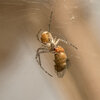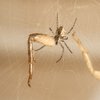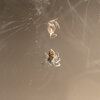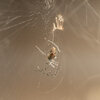Ah Lee
Arachnosquire
- Joined
- May 30, 2020
- Messages
- 147
Thanks Snark, I'll try a rotting fruit/apple cider vinegar trap tomorrow. If I can just get them large enough to take a cricket leg, it'll all be uphill from there. Right now they are so tiny I accidentally drowned one when mistingYou should shortly be seeing two very different sizes. Males will simply stop growing. Fortunately predation among the young is virtually unheard of. Won't do any harm to allow the males to make themselves at home near to each other. When they make webs they will be pretty small at first. One or two inch across orbs. Very cute. Once mature they will often move into the perimeter of the females webs, often living their entire lives there. They are all obligatory web builders. No web, they die. Males will probably get by on fruit flies. Just leave a piece or two of rotting fruit out.They may try using the neighbors webs and food. I've seen 4 or 5 male webs sharing guy lines, right up against each other. Females love moths and are much more independent
Please note, this is all from observations in situ. If they do odd things I'd very much like to read about it.




![IMG_3789[1].jpg IMG_3789[1].jpg](https://arachnoboards.com/data/attachments/312/312286-bf8fd73a4aedee1924c3350dfe7a65cf.jpg)
![IMG_3794[1].jpg IMG_3794[1].jpg](https://arachnoboards.com/data/attachments/312/312287-70867ab3802d4299f3cf37debce1d82b.jpg)















